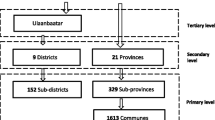Abstract
This paper has a 2-fold objective: (1) To introduce a measure that would be of general applicability in measuring diversity in different institutions. (2) To identify the determinants of diversity in child-care centers and, in particular, to examine whether the for-profit sector is less diverse than the not-for-profit sector in the child-care industry as the statistics suggest. Using our measure, we isolate factors that significantly influence diversity by using an economic model that makes diversity a decision variable of a firm. Two measures of diversity are suggested: absolute diversity and relative diversity (diversity relative to the surrounding community). To select a suitable index, the Herfindahl measure of concentration is considered relative to several suitable ecological indices measuring species diversity, and found to be virtually identical to such indices. Thus theH-index is used in both absolute and relative measures. Empirical estimation of both absolute and relative diversity equations use probability models and isolate factors that significantly influence both absolute diversity of child-care centers as well as their diversity relative to their respective counties. The data used is the recently released Profile of Child-Care Settings collected by the Mathematica Policy Research.
Similar content being viewed by others
References
Adler, Nancy: 1986, International Dimensions of Organizational Behavior (Kent Publishing Co., Boston).
Cover, M. and Joy A. Thomas: 1991, Elements of Information Theory (Wiley, New York).
Cox, Taylor H.: 1991, ‘Managing cultural diversity: implications for organizational effectiveness’, Academy of Management Executive 5, pp. 45–56.
Cox, Jr., Taylor and Stella Nkomo: Nov. 1991, ‘A race and gender group analysis of the early career experience of MBA's’, Work and Occupations 18, pp. 431–446.
Hansmann, H.: 1981, ‘Nonprofit enterprise in the performing arts’, Bell Journal of Economics 12, pp. 341–361.
Hayes, C. D., J. Palmer and M. Zaslow: 1990, ‘Who cares for America's children?’ Child Care Policy for the 1990's, Panel on Child Care Policy, Committee on Child Development Research and Public Policy, Commission on Behavioral and Social Sciences and Education, National Research Council (National academy Press, Washington, DC).
Horowitz, Ira: 1971, ‘Numbers-equivalents in U.S. manufacturing industries’, Southern Economic Journal 37, pp. 396–408.
Kisker, E. E. and V. Piper: 1992, A Profile of Child Care Settings: Center-Based Programs: A User's Guide to the Machine-readable Files and Documentation (Sociometrics Corporation, American Family Data Archive, Los Altos, CA).
Magurran, Anne E.: 1988, Ecological Diversity and Its Measurement (University Press, Princeton).
Marfels: 1971, ‘The consistency of concentration measures’, Southern Economic Journal 37, pp. 203–208.
Mukerjee, Swati: 1993, ‘A note on the efficiency of nonprofit firms and a test to reveal their objectives’, Bentley College Working Paper Series WP-93-018.
Nemeth, Charlan Jeanne: 1986, ‘Differential contributions of majority and minority influence’, Psychological Review 93, pp. 23–32.
Parker, S. C.: 1991, ‘Significantly concentrated markets theory and evidence for the U.K.’, International Journal of Industrial Organization 9, pp. 585–590.
Pielou, E. C.: 1975, Ecological Diversity (Wiley, New York).
Preston, A.: 1993, ‘Efficiency, quality and social externalities in the provision of day care: comparisons of nonprofit and for-profit firms’, in Griliches Zvi and Jacques Mairesse (eds.), Productivity Issues in services at the Micro Level (Kluwer Academic Publishers, Boston).
Schwartz, Felice: 1989, ‘Management women and the new facts of life’, Harvard Business Review January/February, 65–76.
Shaw, M. E.: The Psychology of Small Group Behavior (McGraw Hill, New York).
Simpson, E. H.: 1949, ‘Measurement of diversity’, Nature 163, p. 688.
Triandis, H. C., E. R. Hall and R. B. Ewen: 1965, ‘Member homogeneity and dryadic creativity’, Human Relations 18, pp. 33–54.
Youngblood, Steward A. and Kimberly Chambers-Cook: 1984, ‘Child care assistance can improve employee attitudes and behavior’, Personnel Administrator February, 93–95.
Author information
Authors and Affiliations
Rights and permissions
About this article
Cite this article
Haughton, D.M.A., Mukerjee, S. The economic measurement and determinants of diversity. Soc Indic Res 36, 201–225 (1995). https://doi.org/10.1007/BF01078814
Accepted:
Issue Date:
DOI: https://doi.org/10.1007/BF01078814




